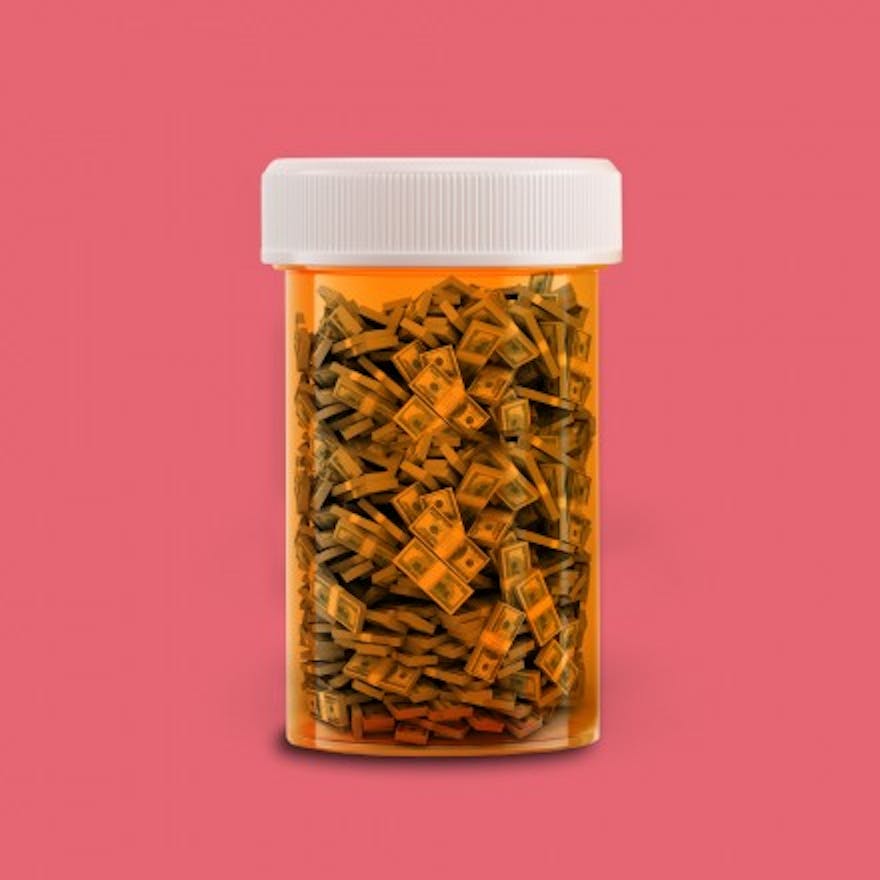Hvaš ręšur geršum stjórnvalda. Lyfjaišnašurinn eyddi įriš 2019, 295 milljónum dollara, eša 40.214.400.000 kr. ķ aš hafa eftirlit meš stjórnvöldum og lagasetningu. Žaš er tvöfalt meira en ašrir. Alls ekki mį nota trausta allmenna žekkingu, eša žraut reynd lyf sem kosta lķtiš, og virka vel.
000
Big Pharma Prepares to Profit From the Coronavirus
Pharmaceutical companies view the coronavirus pandemic as a once-in-a-lifetime business opportunity.
March 13 2020, 6:46 p.m.
https://theintercept.com/2020/03/13/big-pharma-drug-pricing-coronavirus-profits/
000
Hér er ég aš velta žvķ fyrir mér, hvaš rįši stjórnvaldsašgeršum ķ dag.
Lyfja išnašurinn eyddi įriš 2019, 295 milljónum dollara, eša 40.214.400.000 kr. ķ aš hafa eftirlit meš geršum stjórnmįlamanna og embęttismanna og allra žeirra sem hafa įhrif stjórnsżsluna og Žį lagasetninguna.
Žaš er um tvöfalt meira en žeir sem koma nęstir, Alls ekki mį nota trausta allmenna žekkingu, eša žraut reynd lyf sem kosta lķtiš, og virka vel.
000
Among the drugs that were developed with some public funding and went on to be huge earners for private companies are the HIV drug AZT and the cancer treatment Kymriah, which Novartis now sells for $475,000.
((Kostar 64.752.000 kr) og slóšin bakviš $ dollara töluna hér į undan er
https://nucleusbiologics.com/resources/kymriah-vs-yescarta/ )
In his book “Pharma,” Posner points to another example of private companies making exorbitant profits from drugs produced with public funding. The antiviral drug sofosbuvir, which is used to treat hepatitis C, stemmed from key research funded by the National Institutes of Health.
That drug is now owned by Gilead Sciences, which charges
$1,000 per pill — (136.320 kr jg)
more than many people with hepatitis C can afford; Gilead earned $44 billion from the drug during its first three years on the market. …
Instead, the profits have funded huge bonuses for drug company executives and aggressive marketing of drugs to consumers.
They have also been used to further boost the profitability of the pharmaceutical sector.
According to calculations by Axios, drug companies make 63 percent of total health care profits in the U.S. That’s in part because of the success of their lobbying efforts.
In 2019, the pharmaceutical industry spent $295 million on lobbying, far more than any other sector in the U.S.
That’s almost twice as much as the next biggest spender — the electronics, manufacturing, and equipment sector — and well more than double what oil and gas companies spent on lobbying.
The industry also spends lavishly on campaign contributions to both Democratic and Republican lawmakers. Throughout the Democratic primary, Joe Biden has led the pack among recipients of contributions from the health care and pharmaceutical industries.
000
How Big Pharma Will Profit From the Coronavirus
As the new coronavirus spreads illness, death, and catastrophe around the world, virtually no economic sector has been spared from harm. Yet amid the mayhem from the global pandemic, one industry is not only surviving, it is profiting handsomely.
“Pharmaceutical companies view Covid-19 as a once-in-a-lifetime business opportunity,” said Gerald Posner, author of “Pharma: Greed, Lies, and the Poisoning of America.” The world needs pharmaceutical products, of course. For the new coronavirus outbreak, in particular, we need treatments and vaccines and, in the U.S., tests. Dozens of companies are now vying to make them.
“They’re all in that race,” said Posner, who described the potential payoffs for winning the race as huge. The global crisis “will potentially be a blockbuster for the industry in terms of sales and profits,” he said, adding that “the worse the pandemic gets, the higher their eventual profit.”
Join Our Newsletter
Original reporting. Fearless journalism. Delivered to you.
The ability to make money off of pharmaceuticals is already uniquely large in the U.S., which lacks the basic price controls other countries have, giving drug companies more freedom over setting prices for their products than anywhere else in the world. During the current crisis, pharmaceutical makers may have even more leeway than usual because of language industry lobbyists inserted into an $8.3 billion coronavirus spending package, passed last week, to maximize their profits from the pandemic.
Initially, some lawmakers had tried to ensure that the federal government would limit how much pharmaceutical companies could reap from vaccines and treatments for the new coronavirus that they developed with the use of public funding. In February, Rep. Jan Schakowsky, D-Ill., and other House members wrote to Trump pleading that he “ensure that any vaccine or treatment developed with U.S. taxpayer dollars be accessible, available and affordable,” a goal they said couldn’t be met “if pharmaceutical corporations are given authority to set prices and determine distribution, putting profit-making interests ahead of health priorities.”
 Read Our Complete CoverageThe Coronavirus Crisis
Read Our Complete CoverageThe Coronavirus CrisisWhen the coronavirus funding was being negotiated, Schakowsky tried again, writing to Health and Human Services Secretary Alex Azar on March 2 that it would be “unacceptable if the rights to produce and market that vaccine were subsequently handed over to a pharmaceutical manufacturer through an exclusive license with no conditions on pricing or access, allowing the company to charge whatever it would like and essentially selling the vaccine back to the public who paid for its development.”
But many Republicans opposed adding language to the bill that would restrict the industry’s ability to profit, arguing that it would stifle research and innovation. And although Azar, who served as the top lobbyist and head of U.S. operations for the pharmaceutical giant Eli Lilly before joining the Trump administration, assured Schakowsky that he shared her concerns, the bill went on to enshrine drug companies’ ability to set potentially exorbitant prices for vaccines and drugs they develop with taxpayer dollars.
The final aid package not only omitted language that would have limited drug makers’ intellectual property rights, it also left out language that had been in an earlier draft that would have allowed the federal government to take any action if it has concerns that the treatments or vaccines developed with public funds are priced too high.
“Those lobbyists deserve a medal from their pharma clients because they killed that intellectual property provision,” said Posner, who added that the omission of language allowing the government to respond to price gouging was even worse. “To allow them to have this power during a pandemic is outrageous.”
The truth is that profiting off public investment is also business as usual for the pharmaceutical industry. Since the 1930s, the National Institutes of Health has put some $900 billion into research that drug companies then used to patent brand-name medications, according to Posner’s calculations. Every single drug approved by the Food and Drug Administration between 2010 and 2016 involved science funded with tax dollars through the NIH, according to the advocacy group Patients for Affordable Drugs. Taxpayers spent more than $100 billion on that research.
Among the drugs that were developed with some public funding and went on to be huge earners for private companies are the HIV drug AZT and the cancer treatment Kymriah, which Novartis now sells for $475,000.
In his book “Pharma,” Posner points to another example of private companies making exorbitant profits from drugs produced with public funding. The antiviral drug sofosbuvir, which is used to treat hepatitis C, stemmed from key research funded by the National Institutes of Health. That drug is now owned by Gilead Sciences, which charges $1,000 per pill — more than many people with hepatitis C can afford; Gilead earned $44 billion from the drug during its first three years on the market.
“Wouldn’t it be great to have some of the profits from those drugs go back into public research at the NIH?” asked Posner.
Instead, the profits have funded huge bonuses for drug company executives and aggressive marketing of drugs to consumers. They have also been used to further boost the profitability of the pharmaceutical sector. According to calculations by Axios, drug companies make 63 percent of total health care profits in the U.S. That’s in part because of the success of their lobbying efforts. In 2019, the pharmaceutical industry spent $295 million on lobbying, far more than any other sector in the U.S. That’s almost twice as much as the next biggest spender — the electronics, manufacturing, and equipment sector — and well more than double what oil and gas companies spent on lobbying. The industry also spends lavishly on campaign contributions to both Democratic and Republican lawmakers. Throughout the Democratic primary, Joe Biden has led the pack among recipients of contributions from the health care and pharmaceutical industries.
 Read Our Complete CoverageThe Coronavirus Crisis
Read Our Complete CoverageThe Coronavirus CrisisBig Pharma’s spending has positioned the industry well for the current pandemic. While stock markets have plummeted in reaction to the Trump administration’s bungling of the crisis, more than 20 companies working on a vaccine and other products related to the new SARS-CoV-2 virus have largely been spared. Stock prices for the biotech company Moderna, which began recruiting participants for a clinical trial of its new candidate for a coronavirus vaccine two weeks ago, have shot up during that time.
On Thursday, a day of general carnage in the stock markets, Eli Lilly’s stock also enjoyed a boost after the company announced that it, too, is joining the effort to come up with a therapy for the new coronavirus. And Gilead Sciences, which is at work on a potential treatment as well, is also thriving. Gilead’s stock price was already up since news that its antiviral drug remdesivir, which was created to treat Ebola, was being given to Covid-19 patients. Today, after Wall Street Journal reported that the drug had a positive effect on a small number of infected cruise ship passengers, the price went up further.
Several companies, including Johnson & Johnson, DiaSorin Molecular, and QIAGEN have made it clear that they are receiving funding from the Department of Health and Human Services for efforts related to the pandemic, but it is unclear whether Eli Lilly and Gilead Sciences are using government money for their work on the virus. To date, HHS has not issued a list of grant recipients. And according to Reuters, the Trump administration has told top health officials to treat their coronavirus discussions as classified and excluded staffers without security clearances from discussions about the virus.
Former top lobbyists of both Eli Lilly and Gilead now serve on the White House Coronavirus Task Force. Azar served as director of U.S. operations for Eli Lilly and lobbied for the company, while Joe Grogan, now serving as director of the Domestic Policy Council, was the top lobbyist for Gilead Sciences.



 agny
agny
Bęta viš athugasemd [Innskrįning]
Ekki er lengur hęgt aš skrifa athugasemdir viš fęrsluna, žar sem tķmamörk į athugasemdir eru lišin.